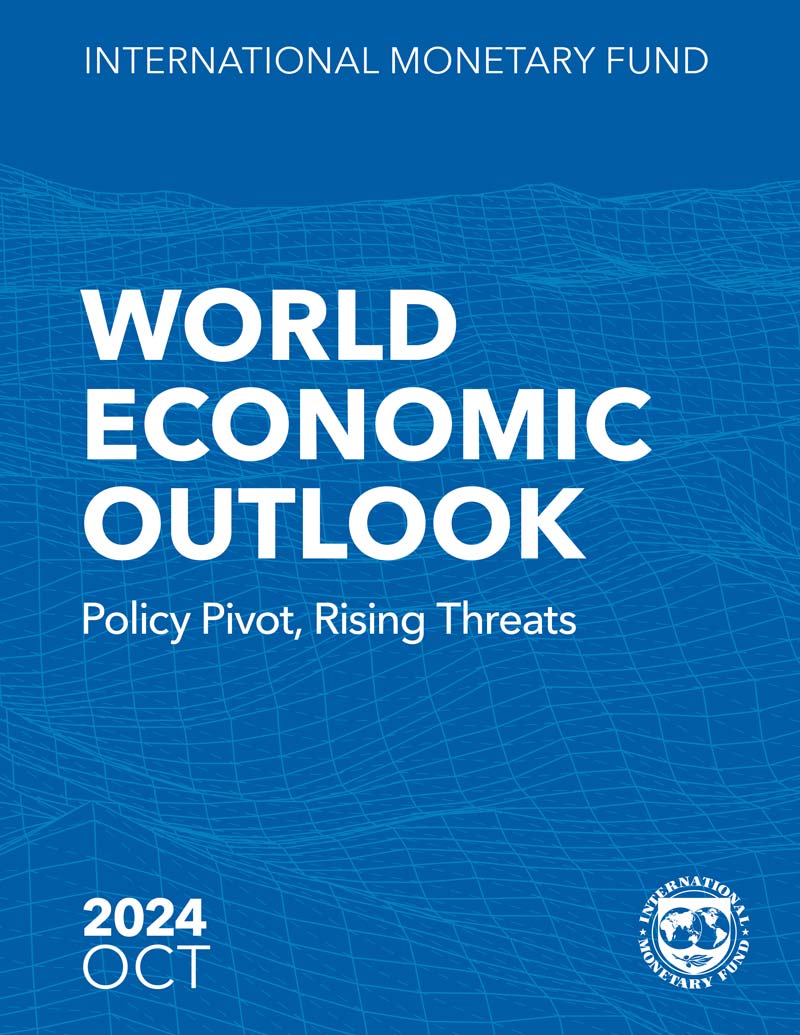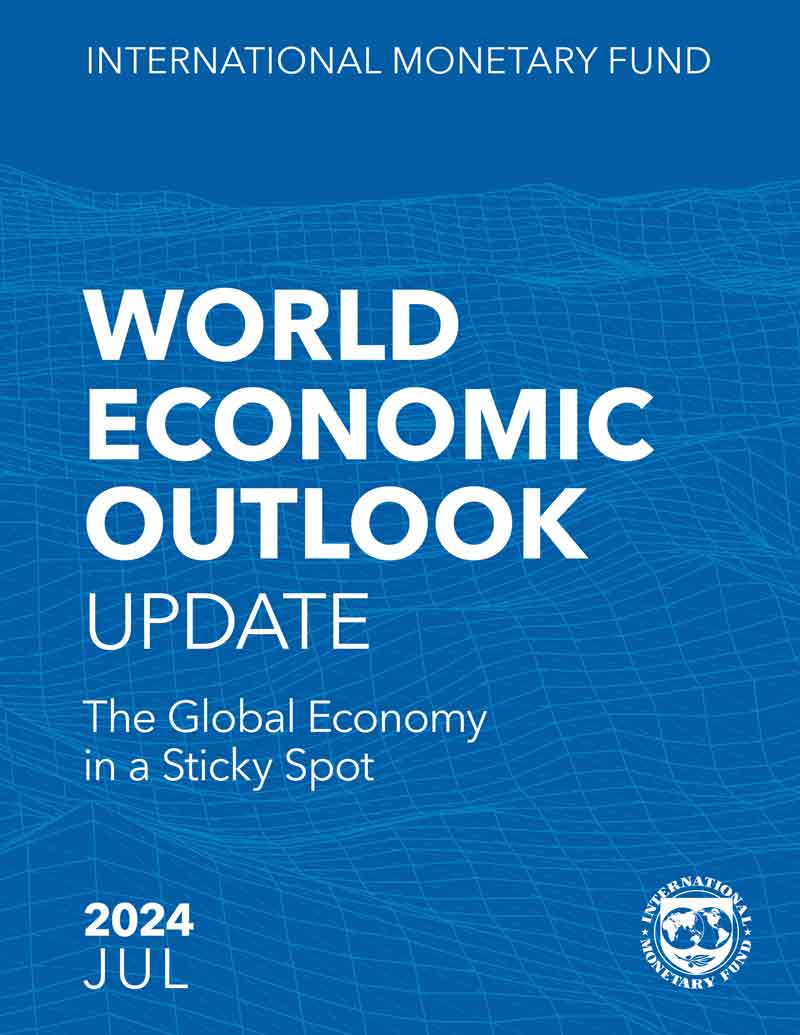World Economic Outlook - All Issues
The World Economic Outlook (WEO) is a survey of prospects and policies by the IMF staff, usually published twice a year, with updates in between. It presents analyses and projections of the world economy in the near and medium term, which are integral elements of the IMF’s surveillance of economic developments and policies in its member countries and of the global economic system. They consider issues affecting advanced, emerging and developing economies, and address topics of pressing current interest.
See also, the World Economic Databases
November 23, 2024
2024
World Economic Outlook, October 2024: Policy Pivot, Rising Threats
October 22, 2024
Description:
Policy Pivot, Rising Threats The latest World Economic Outlook reports stable but underwhelming global growth, with the balance of risks tilted to the downside. As monetary policy is eased amid continued disinflation, shifting gears is needed to ensure that fiscal policy is on a sustainable path and to rebuild fiscal buffers. Understanding the role of monetary policy in recent global disinflation, and the factors that influence the social acceptability of structural reforms, will be key to promoting stable and more rapid growth in the future.
World Economic Outlook Update, July 2024: The Global Economy in a Sticky Spot
July 16, 2024
Description:
The Global Economy in a Sticky Spot Global growth is projected to be in line with the April 2024 World Economic Outlook (WEO) forecast, at 3.2 percent in 2024 and 3.3 percent in 2025. Services inflation is holding up progress on disinflation, which is complicating monetary policy normalization. Upside risks to inflation have thus increased, raising the prospect of higher for even longer interest rates, in the context of escalating trade tensions and increased policy uncertainty. The policy mix should thus be sequenced carefully to achieve price stability and replenish diminished buffers.
World Economic Outlook, April 2024: Steady but Slow: Resilience amid Divergence
April 16, 2024
Description:
Steady but Slow: Resilience amid Divergence The baseline forecast is for the world economy to continue growing at 3.2 percent during 2024 and 2025, at the same pace as in 2023. A slight acceleration for advanced economies—where growth is expected to rise from 1.6 percent in 2023 to 1.7 percent in 2024 and 1.8 percent in 2025—will be offset by a modest slowdown in emerging market and developing economies from 4.3 percent in 2023 to 4.2 percent in both 2024 and 2025. The forecast for global growth five years from now—at 3.1 percent—is at its lowest in decades. Global inflation is forecast to decline steadily, from 6.8 percent in 2023 to 5.9 percent in 2024 and 4.5 percent in 2025, with advanced economies returning to their inflation targets sooner than emerging market and developing economies. Core inflation is generally projected to decline more gradually. The global economy has been surprisingly resilient, despite significant central bank interest rate hikes to restore price stability. Chapter 2 explains that changes in mortgage and housing markets over the prepandemic decade of low interest rates moderated the near-term impact of policy rate hikes. Chapter 3 focuses on medium-term prospects and shows that the lower predicted growth in output per person stems, notably, from persistent structural frictions preventing capital and labor from moving to productive firms. Chapter 4 further indicates how dimmer prospects for growth in China and other large emerging market economies will weigh on trading partners.
World Economic Outlook Update, January 2024: Moderating Inflation and Steady Growth Open Path to Soft Landing
January 30, 2024
Description: Global growth is projected to stay at 3.1 percent in 2024 and rise to 3.2 percent in 2025. Elevated central bank rates to fight inflation and a withdrawal of fiscal support amid high debt weigh on economic activity. Inflation is falling faster than expected in most regions, amid unwinding supply-side issues and restrictive monetary policy. Global headline inflation is expected to fall to 5.8 percent in 2024 and 4.4 percent in 2025, with the 2025 forecast having been revised down.
2023
World Economic Outlook, October 2023: Navigating Global Divergences
October 10, 2023
Description: The latest World Economic Outlook reports signs that policy tightening is starting to cool activity despite core inflation proving persistent. Risks are more balanced as banking sector stress has receded, but they remain tilted to the downside.
World Economic Outlook Update, July 2023: Near-Term Resilience, Persistent Challenges
July 25, 2023
Description: Global growth is projected to fall from an estimated 3.5 percent in 2022 to 3.0 percent in both 2023 and 2024. The rise in central bank policy rates to fight inflation continues to weigh on economic activity. Global headline inflation is expected to fall from 8.7 percent in 2022 to 6.8 percent in 2023 and 5.2 percent in 2024. Underlying (core) inflation is projected to decline more gradually, and forecasts for inflation in 2024 have been revised upward.
World Economic Outlook, April 2023: A Rocky Recovery
April 11, 2023
Description: The baseline forecast is for growth to fall from 3.4 percent in 2022 to 2.8 percent in 2023, before settling at 3.0 percent in 2024. Advanced economies are expected to see an especially pronounced growth slowdown, from 2.7 percent in 2022 to 1.3 percent in 2023. In a plausible alternative scenario with further financial sector stress, global growth declines to about 2.5 percent in 2023 with advanced economy growth falling below 1 percent. Global headline inflation in the baseline is set to fall from 8.7 percent in 2022 to 7.0 percent in 2023 on the back of lower commodity prices but underlying (core) inflation is likely to decline more slowly. Inflation’s return to target is unlikely before 2025 in most cases.
Inflation Peaking amid Low Growth
January 30, 2023
Description: The January 2023 World Economic Outlook Update projects that global growth will fall to 2.9 percent in 2023 but rise to 3.1 percent in 2024. The 2023 forecast is 0.2 percentage point higher than predicted in the October 2022 World Economic Outlook but below the historical average of 3.8 percent. Rising interest rates and the war in Ukraine continue to weigh on economic activity. China’s recent reopening has paved the way for a faster-than-expected recovery. Global inflation is expected to fall to 6.6 percent in 2023 and 4.3 percent in 2024, still above pre-pandemic levels.
2022
World Economic Outlook, October 2022: Countering the Cost-of-Living Crisis
October 11, 2022
Description: Global economic activity is experiencing a broad-based and sharper-than-expected slowdown, with inflation higher than seen in several decades. The cost-of-living crisis, tightening financial conditions in most regions, Russia’s invasion of Ukraine, and the lingering COVID-19 pandemic all weigh heavily on the outlook. Global growth is forecast to slow from 6.0 percent in 2021 to 3.2 percent in 2022 and 2.7 percent in 2023. This is the weakest growth profile since 2001 except for the global financial crisis and the acute phase of the COVID-19 pandemic. Global inflation is forecast to rise from 4.7 percent in 2021 to 8.8 percent in 2022 but to decline to 6.5 percent in 2023 and to 4.1 percent by 2024. Monetary policy should stay the course to restore price stability, and fiscal policy should aim to alleviate the cost-of-living pressures while maintaining a sufficiently tight stance aligned with monetary policy. Structural reforms can further support the fight against inflation by improving productivity and easing supply constraints, while multilateral cooperation is necessary for fast-tracking the green energy transition and preventing fragmentation.
World Economic Outlook Update, July 2022: Gloomy and More Uncertain
July 26, 2022
Description: A tentative recovery in 2021 has been followed by increasingly gloomy developments in 2022 as risks began to materialize. Global output contracted in the second quarter of this year, owing to downturns in China and Russia, while US consumer spending undershot expectations. Several shocks have hit a world economy already weakened by the pandemic: higher-than-expected inflation worldwide––especially in the United States and major European economies––triggering tighter financial conditions; a worse-than-anticipated slowdown in China, reflecting COVID- 19 outbreaks and lockdowns; and further negative spillovers from the war in Ukraine.





